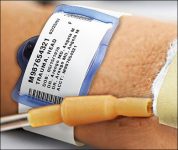
Geisinger Community Medical Center uses RTLS bracelet tags to track patient location
[ad_1]
The Geisinger Community Medical Center (G-CMC) in Pennsylvania is using disposable CenTrak wristband tags to provide patients’ families and caregivers with patient location information.
Kelly Worsnick, manager of G-CMC’s emergency department, said that G-CMC does not use disposable labels due to cost factors, but to improve the quality of services for patients and their families.

Approximately 80% of G-CMC emergency department patients go home and rest overnight. The remaining 20% of patients will be nursed overnight in the hospital or transferred to other departments. It is a very time-consuming task for the family members and medical staff of the patient to find the location of the patient. The CenTrak disposable wristband tag was developed to solve this problem. In addition, the disposable wristband tag is cheaper to use than the reusable version. Reused wristband labels are often lost and costly to disinfect.
When arriving at the hospital, the hospital will distribute a standard plastic ID bracelet with a disposable CenTrak tag attached. A unique identifier will also be printed on the front of the label so that employees can bind other patient information on the TeleTracking software. A barcode is also printed on the bracelet label, and employees can scan the barcode to enter the identifier.
The hospital also installed CenTrak’s second-generation infrared beacon (Gen2IR) throughout the hospital. After the bracelet tag receives the ID number sent by the infrared beacon within the range, it will use the UHF signal to send information such as a unique identifier. Then, the CenTrak Gen2IR RFID reader will receive this data and transmit it to the CenTrak location server. After receiving the unknown data, the TeleTracking software will display the location of the wearer of the bracelet on the video monitor.
The hospital uses video monitors, and the computer displays the real-time location of each patient by name. Currently, these location information is not open to the outside world. The doctor or family member can ask the staff about the patient’s current location.
When the patient is discharged from the hospital, the entire bracelet will be placed in the CenTrak ITK 363 label storage box. The built-in Gen2IR reader will read the tag ID number and upload it to the software to update the patient’s discharge information. The cleaning staff can log in to the software to check the position of the patient’s bed and clean it.
Worsnick said that the patient tracking system officially started piloting in June 2015 and has now entered the stage of permanent deployment. The hospital intends to continue to use the program to provide location information to family members and caregivers. At the same time, the hospital will also use more functions. For example, hospitals can bind patients and their used medical equipment information. In this way, when an infectious disease patient uses a certain medical device for treatment. The staff can perform key disinfection on this.
Last year, CenTrak released this disposable bracelet label, which aims to make the RTLS traceability system more affordable. CenTrak CEO Ari Naim said: “Label prices have always been an obstacle to the popularity of tracking systems. Reusable labels are relatively expensive and costly to disinfect. Of course, CenTrak will still produce reusable labels.”
(Exclusive manuscript of rfid world network, please indicate the source author for reprinting!)
[ad_2]



